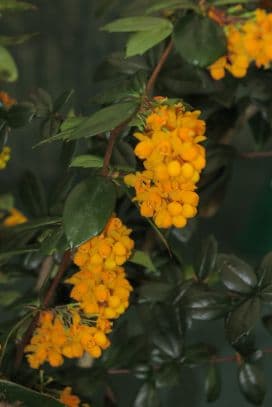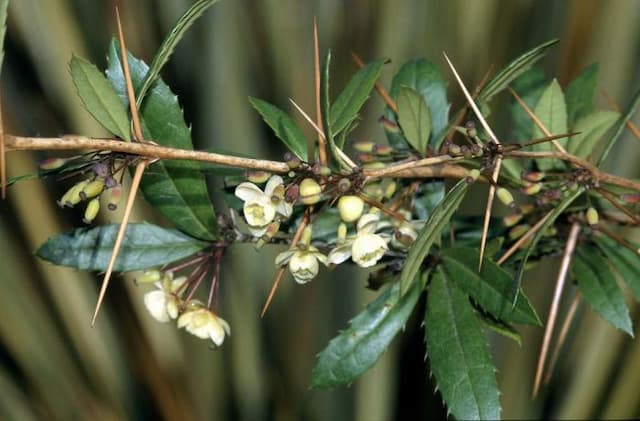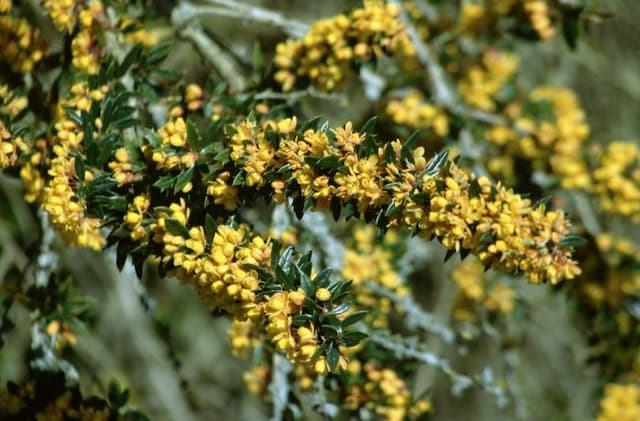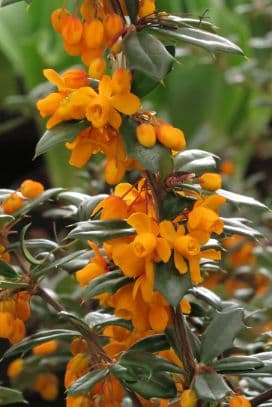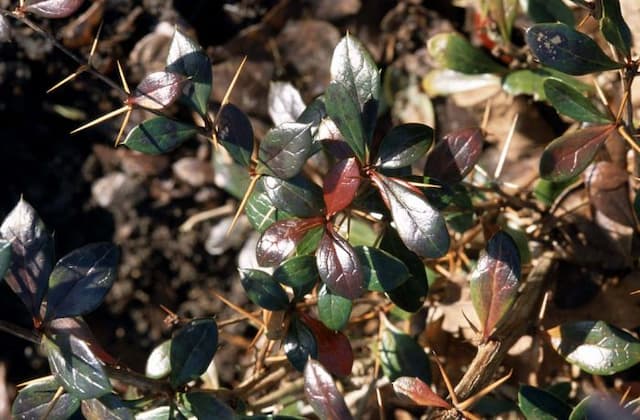Japanese barberry Berberis thunbergii Bonanza Gold = 'Bogozam' (PBR)
![Japanese barberry [Bonanza Gold]](/_next/image?url=https%3A%2F%2Fplants-admin.emdemapps.com%2Fimages%2Fplants%2F%2Fimages%2F604b5385e413f.png&w=3840&q=75)
ABOUT
Berberis thunbergii Bonanza Gold, commonly known as the Bonanza Gold Barberry, is a striking ornamental shrub known for its vibrant foliage and compact growth habit. It boasts a multitude of small leaves that are a bright, eye-catching golden yellow, which can turn orange-yellow in cooler autumn temperatures. The leaves are small and oval-shaped, providing a dense and lush appearance. The overall form of the Bonanza Gold is dense and mounded, with branches that grow in a slightly arching manner, adding to its visual interest. This makes it a favorite for gardeners looking to add a splash of color to their landscape. The stems of this plant possess sharp thorns which are something to be mindful of when handling or planting. In spring, the Bonanza Gold Barberry produces tiny, inconspicuous flowers that are pale yellow to red in color. These flowers may attract some garden visitors, but they are not the main draw of the plant. Instead, its foliage remains the primary feature throughout the seasons. During the year, the shrub's vibrant color is a beacon in garden settings, easily pairing with a variety of other plants and fitting into different garden designs, from the formal to the more naturalistic. Despite the elimination of specific size details, the Berberis thunbergii Bonanza Gold is recognized as a manageable plant, suitable for a range of garden spaces.
About this plant
 Names
NamesFamily
Berberidaceae.
Synonyms
Japanese Barberry, Thunberg's Barberry, Bonanza Gold Barberry.
Common names
Berberis thunbergii 'Bogozam'
 Toxicity
ToxicityTo humans
The Japanese barberry is not generally considered highly toxic to humans, but it may cause mild stomach upset if ingested. The most common symptoms after ingestion can include nausea, vomiting, diarrhea, and abdominal pain. In most cases, the symptoms are self-limiting and resolve without the need for medical treatment. Nonetheless, caution should be exercised to prevent children from ingesting the berries or any other parts of the plant.
To pets
Japanese barberry is similarly not highly poisonous to pets, but it can cause gastrointestinal upset if ingested. Pets may exhibit symptoms such as vomiting, diarrhea, or a lack of appetite. While severe toxicity is rare, it is still advisable to keep pets away from the plant to prevent any possible discomfort or complications arising from ingestion.
 Characteristics
CharacteristicsLife cycle
Perennials
Foliage type
Deciduous
Color of leaves
Gold
Flower color
Yellow
Height
2 feet [60 cm]
Spread
3 feet [90 cm]
Plant type
Shrub
Hardiness zones
5
Native area
Japan
Benefits
 General Benefits
General Benefits- Aesthetic Appeal: Adds vibrant yellow foliage to gardens, creating color contrast against green landscapes.
- Low Maintenance: Once established, it requires minimal care, making it suitable for busy gardeners.
- Seasonal Interest: Offers year-round interest with its foliage, and in spring, it may have small, attractive flowers.
- Drought Tolerance: Can survive in dry conditions after establishment, reducing the need for frequent watering.
- Compact Size: Ideal for small gardens or spaces due to its dwarf nature.
- Deer Resistance: Less likely to be damaged by deer, which can be an issue in some regions.
- Erosion Control: Can be used on slopes to help prevent soil erosion with its root system.
 Medical Properties
Medical PropertiesThis plant is not used for medical purposes.
 Air-purifying Qualities
Air-purifying QualitiesThis plant is not specifically known for air purifying qualities.
 Other Uses
Other Uses- Dye production: Barberry plants like 'Bogozam' can be used as a natural source of dye for fabrics, producing colors ranging from yellow to deep orange depending on the mordant used in the dyeing process.
- Bonsai art: Due to its compact growth and bright foliage, 'Bogozam' is suitable for bonsai cultivation, allowing enthusiasts to train and shape it into miniature landscapes.
- Garden barrier: The spiny branches can form an effective barrier against small animals, as they might avoid crossing through the prickly hedge.
- Culinary decoration: The bright golden-yellow leaves can be used as natural garnish for food presentation in high-end culinary establishments.
- Photography prop: Photographers may use 'Bogozam' for its striking foliage as a background plant in garden and nature photography.
- Soil erosion control: The plant's dense root system can help in stabilizing soil on slopes and preventing erosion.
- Color contrast in floristry: Florists might use cut foliage of 'Bogozam' for creating contrast in floral arrangements, especially in autumn-themed bouquets.
- Winter garden interest: With its persistent leaves in mild winters, 'Bogozam' can provide color in otherwise barren winter landscapes.
- Festive decoration: The vibrant foliage can be incorporated into wreaths and other festive decorations, especially in the fall season.
- Craft material: The wood of 'Bogozam' can be harvested and used in crafting small items or in woodturning projects for decorative purposes.
Interesting Facts
 Feng Shui
Feng ShuiThe Japanese barberry is not used in Feng Shui practice.
 Zodiac Sign Compitability
Zodiac Sign CompitabilityThe Japanese barberry is not used in astrology practice.
 Plant Symbolism
Plant Symbolism- Protection: The species Berberis thunbergii, commonly referred to as the Japanese barberry, has thorns that are often interpreted as a natural form of protection. This symbolism extends to the 'Bonanza Gold' variety, representing the idea of safeguarding and defense.
- Adaptability: The Berberis thunbergii 'Bonanza Gold' showcases a vibrant, adaptable nature due to its ability to thrive in various climates and conditions, which can symbolize resilience and flexibility in life's challenges.
- Sharpness: Reflecting the sharp thorns of the Berberis thunbergii, this plant can symbolize a sharp mind or wit, perhaps indicating intelligence or the need for mental alertness.
 Water
WaterThe Japanese Barberry 'Bonanza Gold' typically requires consistent moisture but does not do well with waterlogged conditions. Water the plant deeply once a week, ensuring the water reaches the root zone. During dry periods or hot spells, increase watering to twice per week. It's important to avoid frequent light waterings as they encourage shallow root systems. For mature plants, providing approximately 1 to 1.5 gallons of water per week should be sufficient.
 Light
LightJapanese Barberry 'Bonanza Gold' thrives best in full sun to part shade. The ideal spot for this plant is one where it can receive at least six hours of direct sunlight daily. The bright light helps to enhance the foliage's golden color, but it can also tolerate partial shade where it receives some afternoon shade or dappled sunlight.
 Temperature
TemperatureThe Japanese Barberry 'Bonanza Gold' can withstand a range of temperature conditions, thriving in temperatures as cold as -30°F and as high as 90°F. The ideal growing temperatures for this plant are between 50°F and 80°F. Make sure to plant it in a location that avoids exposure to harsh winds which could damage the plant in colder temperatures.
 Pruning
PruningPruning the Japanese Barberry 'Bonanza Gold' helps to maintain its size, encourage new growth, and remove dead or diseased wood. Prune the plant in late winter or early spring before new growth begins. Lightly trim for shape and to thin out any dense areas. If necessary, more extensive pruning can be done, but avoid heavy pruning as this can reduce the number of flowers and fruit.
 Cleaning
CleaningAs needed
 Soil
SoilThe Japanese Barberry 'Bonanza Gold' prefers well-draining soil with a slightly acidic to neutral pH, ideally between 5.5 and 7.5. A good soil mix would be equal parts garden soil, peat, and perlite or coarse sand to ensure proper drainage and aeration.
 Repotting
RepottingJapanese Barberry 'Bonanza Gold' generally does not require frequent repotting and can be done every 2-3 years to refresh the soil or accommodate root growth.
 Humidity & Misting
Humidity & MistingJapanese Barberry 'Bonanza Gold' is tolerant of a wide range of humidity levels and does not have specific humidity requirements, thriving in average outdoor conditions.
 Suitable locations
Suitable locationsIndoor
Grow in bright light, avoid waterlogging, fertilize monthly.
Outdoor
Plant in full sun to partial shade; mulch and water regularly.
Hardiness zone
4-8 USDA
 Life cycle
Life cycleThe Berberis thunbergii Bonanza Gold, commonly known as Japanese Barberry, begins its lifecycle when seeds disperse, commonly by birds that eat the fruit and excrete the seeds. Germination takes place in spring, with seedlings requiring moist, well-drained soils with ample sunlight. Once established, the shrub enters a vigorous growth phase, characterized by bright golden-yellow foliage and a compact, mounding habit, often requiring several years to reach maturity. During its reproductive stage, the Japanese Barberry produces small yellow flowers in mid-spring, which are followed by bright red berries that persist into winter, providing interest and food for wildlife. As a deciduous shrub, it goes through a dormancy stage in winter, shedding its leaves and conserving energy to resume growth in the spring. The plant can live for many years, with its life span often extended through pruning and proper care.
 Propogation
PropogationPropogation time
Spring-Early Summer
Propogation: The Japanese barberry 'Bonanza Gold' is commonly propagated through cuttings, which is the most popular method. This process involves taking semi-hardwood cuttings of about 4 to 6 inches (10 to 15 centimeters) in length from a healthy parent plant during the late summer months. The cuttings should be taken from new growth that has started to harden but is not yet fully woody. The lower leaves are removed, and the cut end is often dipped in a rooting hormone to encourage root development. The prepared cuttings are then inserted into a well-draining potting mix, ensuring that a couple of nodes are buried where leaves were removed. A humid environment is maintained around the cuttings, sometimes by covering them with a plastic bag or placing them in a greenhouse to keep the humidity high until roots have formed, which can take several weeks.

